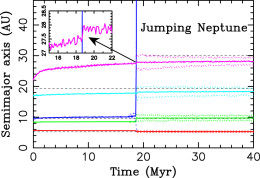A feature of the Kuiper Belt known as the “kernel” has yet to be adequately explained by solar system formation models. In a recent study, a theorist at the Southwest Research Institute proposes a new explanation for how Neptune arrived at its current orbit — and how this planet’s migration in the early years of the solar system might have created the kernel.
Orbital Jump
The kernel is a concentration of orbits within the Kuiper Belt that all have semimajor axes of roughly a ≈ 44 AU, low eccentricities, and low inclinations. How this collection of objects formed — and why they exist where they do — is difficult to explain with current models, however. Kernel objects aren’t in resonance with any of the larger bodies, so why are they concentrated at that specific distance? In this study, David Nesvorný proposes that the kernel resulted from Neptune’s outward migration through the solar system.
In the currently favored model of our solar system’s formation, the outermost gas giant planets formed closer to the Sun and then migrated out to their current locations. Nesvorný ran a series of simulations of this migration to test the theory that a discontinuity in Neptune’s movement outward — i.e., a sudden jump in the planet’s orbital distance — could explain the presence of the Kuiper Belt’s kernel.

Results from a previous study, in which the authors evolved the four gas giant planets plus a fifth giant planet (blue) initially on an orbit between Saturn and Uranus. At 18.3 Myr, a close encounter with the fifth planet causes Neptune’s orbit (pink) to jump outwards by ~0.4 AU, and the fifth planet is then ejected from the solar system by Jupiter. [Nesvorný 2015]
Resonant Population
Nesvorný was successful in finding a model that reproduced the kernel, as well as other observed features of the solar system today. In his model, Neptune began its journey closer to the Sun, at a distance of roughly 24 AU, and it migrated fairly rapidly outward to about 28 AU. As it traveled, it swept up bodies in the outer disk in a 2:1 resonance. These bodies migrated along with it, from an original location of around 40 AU out to 44 AU.
At this point, something occurred to cause Neptune’s orbit to suddenly jump outward by roughly half an AU. The 2:1 population, unable to keep up, were released from the resonance with Neptune here, and they remained orbiting at 44 AU to this day. These bodies are what we now observe as the Kuiper Belt kernel. Neptune, meanwhile, continued to migrate slowly, eventually reaching its current orbit of roughly 30 AU.
Fifth Planet
But what happened to make Neptune’s distance suddenly jump? Nesvorný speculates that Neptune may have had a close encounter with another giant planet — one not currently in our solar system. In a previous study, he inserted a fifth gas giant planet into his simulations with an initial orbit between Saturn and Uranus. Neptune’s orbit jumped by about half an AU when it interacted with the planet at 28 AU, and the fifth planet was subsequently ejected from the solar system by Jupiter.
Citation
David Nesvorný 2015 AJ 150 68. doi:10.1088/0004-6256/150/3/68


1 Comment
Pingback: Kuiper Kore and Jumping Giants!